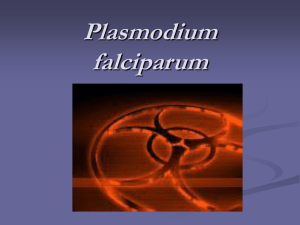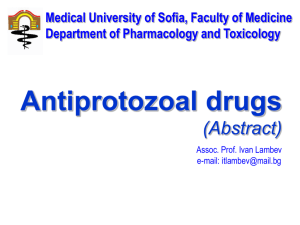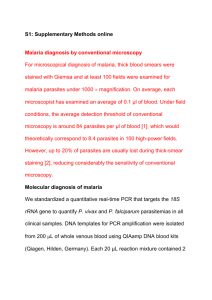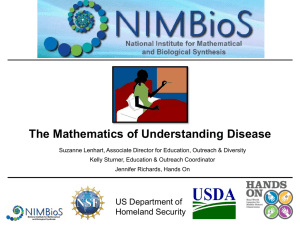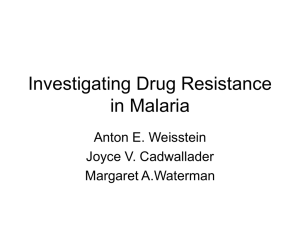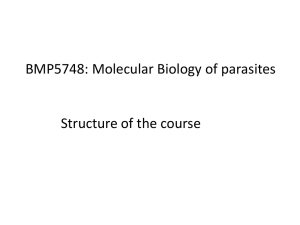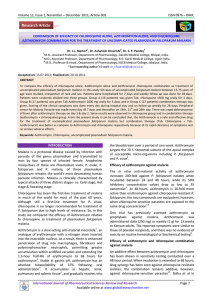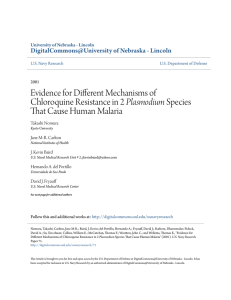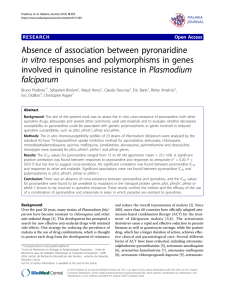The Malarias: Plasmodium falciparum Plasmodium vivax Plasmodium malariae
advertisement
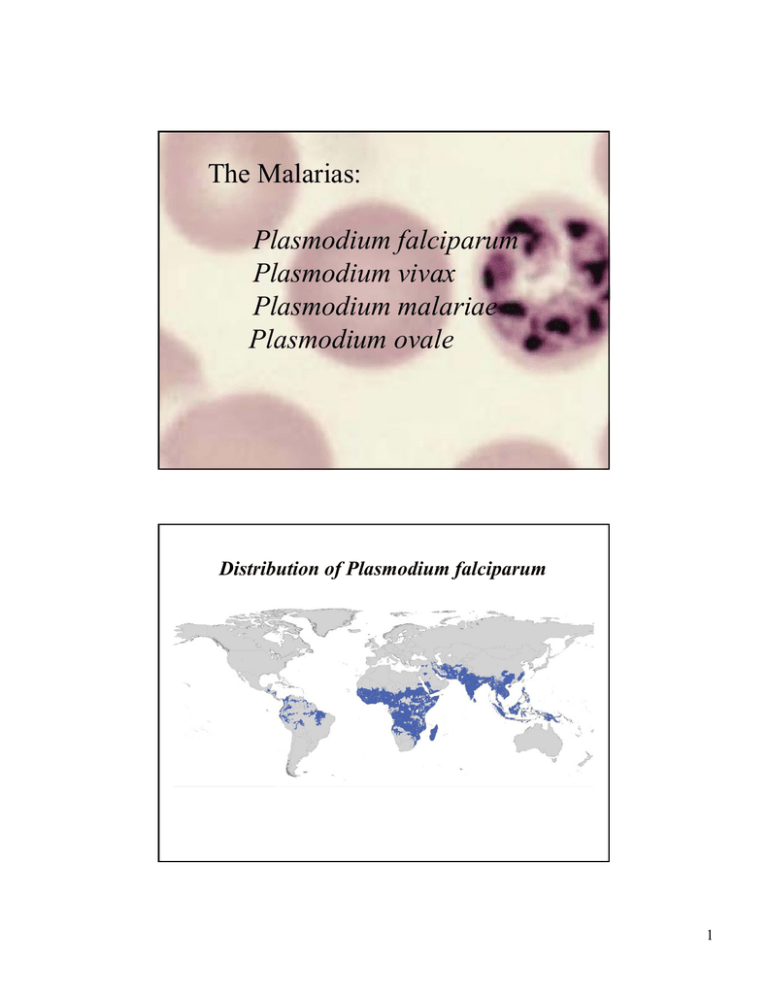
The Malarias: Plasmodium falciparum Plasmodium vivax Plasmodium malariae Plasmodium ovale Distribution of Plasmodium falciparum 1 Distribution Of Plasmodium vivax 2 Global Risk By Country-Proportionality Plot P. falciparum P. vivax 3 million deaths/yr. 1 million in Africa, mostly children below the age of 5 3 Watersheds of the African Continent Population density Mosquitoes are aquatic insects World Situation • Approx. 2 billion infections/yr • Economic and social development reduced • 27% of the world lies within the malaria transmission zone • New unstable transmission area: Bangladesh • Impact of malaria on population change ? 4 Malarious Area of the United States 1934-5 5 Adult Anopheles dirus taking a blood meal from one of the authors (RWG) Plasmodium falciparum 6 Plasmodium vivax Plasmodium ovale 7 Plasmodium malariae 8 Adult Anopheles dirus taking a blood meal from one of the authors (RWG) 9 Ex-flagellation of the microgametocyte of a malaria parasite in mosquito stomach Portion of an infected mosquito stomach. Note numerous oocysts on outer wall. 10 Sporozoites of malaria in infected mosquito stomach preparation 1 μm Light micrograph SEM Photo: Photini Sinnis Entry Of Sporozoites Into Parenchymal Cells Of The Liver From: Ute Frevert NYU School of Medicine 11 Exo-erythrocytic stages of malaria in liver parenchymal cell Plasmodium Anatomy 12 Transmission EM of merozoite entering a red cell. Note points of attachment Mechanisms of Red Cell Invasion By Plasmodium 13 Erythrocytic stages of malaria: All infections begin with the ring stage regardless of the the species Ring stage Pathogenesis • Destruction of erythrocytes; anemia • Liberation of parasite and erythrocyte material into circulation • Host reaction to these events (multiple organ system disease, acidosis in acute disease) • P. falciparum has unique sequestration in microcirculation of vital organs interfering with flow and tissue metabolism • Long-term effects of repeated infections - learning deficit, spontaneous abortion, reduced growth rates; all may be due to prolonged acidosis 14 Clinical Signs & Symptoms • • • • Fever, paroxysms of shaking chills Tertian vs quartan fever pattern Symptoms when other organs involved Hemolysis: icterus, jaundice, enlarged spleen 15 Susceptibility to malaria, antibody production, and lethality. Transmission EM: RBC infected with P. falciparum “Knobs” of histidine-rich protein. Points of attachment to endothelial cell N = Nucleus; F = food vacuole 16 Cerebral malaria: experimental infection in monkey stain: tissue Giemsa Diagnosis 17 Plasmodium falciparum Not in peripheral blood: 16-26 In peripheral blood: 1-15; 27-30 Normal RBC Atomic force microscopy of knobs In situ RBCs with P. falciparum Stages of P. falciparum with knobs Electron micrograph of knobs 18 Plasmodium vivax Infected RBCs larger than non-infected RBCs, Schüffner’s dots Plasmodium ovale Same as P. vivax 19 Plasmodium malariae Infected RBCs same size as non-infected RBCs, No Schüffner’s dots Plasmodium vivax Infected RBCs enlarged Treatment • • • • Type of malaria Knowledge of regional resistance Severity of illness (oral vs intravenous) Age of patient 20 Distribution of Plasmodium falciparum Drug-resistant Malaria Red - chloroquine resistant Green - chloroquine sensitive Black - chloroquine and mefloquine resistant 21 Mode of Action of Chloroquine And Mechanisms of Drug Resistance Chloroquine Stacking enzyme Parasite toxic waste dump: hemozoin (HZ) The parasite uses the protein portion of hemoglobin and discards the heme moiety as hemozoin. Drugs Of Choice: A. Parent Compound C. Newer Derivative Quinine B. Older Derivative: extensive resistance Mefloquine D. Drugs of choice Chloroquine Atovaquon Proguanil 22 Treatment: Anti-Folates Pteridine + PABA (Para-aminobenzoic Acid) Dihydropteroate Synthetase Sulfonamides / Dapsone Folic acid Dihydrofolic acid Dihydrofolate reductase Pyrimethamine, Proguanil Tetrahydrofolic acid Artemesinin Artemisia sp. 23 Shortage of artemesinin: one crop/year Spraying residual DDT 24 Antimalarial Prophylaxis • North American travelers lack immunity to malaria • Risk of acquiring malaria depends on rural travel, altitude, season of travel. • Highest risk in low lying areas during rainy season • Personal protection measures against mosquitoes as important as drugs. • Insect repellants, mosquito nets, clothing covering body • Antimalarial drugs do not prevent infection and initial liver stage Conclusion of article: 20% of the children harbor 80% of the infections because they are bitten more often. Q: Since mosquitoes home in on us via CO2, body temperature and perhaps other odors, is there a genetics controlling our susceptibility to being bitten? 25 Types of Preventive Measures: Drugs • Prophylaxis with medications based on knowledge of geographic resistance patterns • Mefloquine, Doxycycline, Atovaquone-Proguanil • Self treatment: Fansidar, Quinine • Combination of both: Chloroquine chemoprophylaxis with standby Rx (Not Recommended!) • MDR resistance a problem in Thailand, Cambodia and Increasingly E. Africa 26 Future Research • ? Vaccine; none yet but many being tested • New and Better drugs – Safety in Children – Safety in Pregnant Women – ? 1 dose A major reason why there is still no vaccine 27 1,500 languages! 1,500 antigenic strains of P. falciparum! 28

